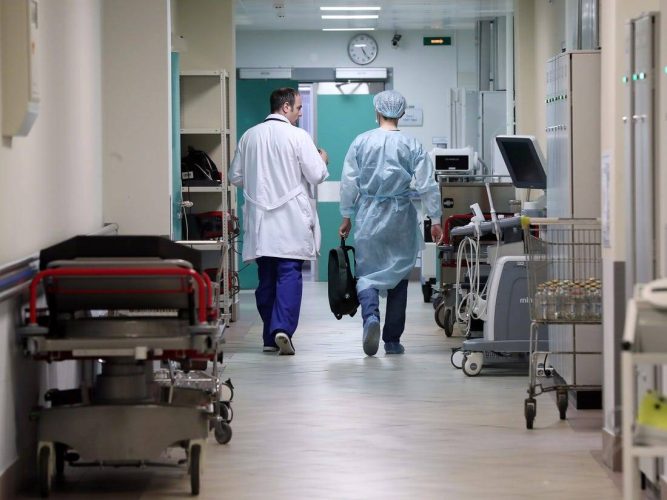Healthcare: US Medicaid Costs Will Hit $1trn By 2027

Categories :
As millions of Americans file for unemployment insurance and joblessness in danger of approaching 1930's levels amid coronavirus outbreak, the skyrocketing costs of the US health care become even more troubling.
Ever growing health care expenses were a massive burden for states even before the COVID-19 pandemic. However, with the US unemployment rate currently at 13.3% the cost of the two big government programs, Medicaid for lower-income people and Medicare for the elderly, are also set to reach record highs.
Total Medicaid expenditure is set to jump 30%, reaching $1trn value by 2027, according to data gathered by LearnBonds.
Medicaid Costs Have Jumped $270.5bn Since 2010
US health care costs have surged in recent years, with medical bills becoming a burden for millions of Americans already dealing with mortgages or credit card debt. Rising prices among hospitals and other health care providers, along with an increasing number of people on a low-income, has caused Medicaid spending to lift as well.
In 2010, the combined cost of the Medicaid program amounted to $401.5bn, revealed Statista data and the United States Department of Health & Human Services report. By the end of 2015, this figure rose to $549.1bn. The rising trend continued in the following years, with the Medicaid expenditure reaching almost $640bn value in 2019, the highest point in US history.
Statistics show the total cost of the US public health insurance program that aims to provide affordable health care options to low-income residents and people with disabilities is expected to touch $672bn in 2020, a $270.5 increase over the last decade.
Medicaid federal expenditure represents the majority of that figure, or $418.7bn, while state costs amount to $254bn in 2020. Over the next seven years, these figures are set to hit $624.8bn and $383bn, respectively.
Analyzed by geography, California has the highest Medicaid cost among all US states. Statistics show this figure touched $83.87bn in 2018. The state of New York ranked second with $74.8bn worth Medicaid expenses the same year. Texas and Pennsylvania followed with $38.2bn and $30bn, respectively.
US Medicaid Enrollment to Hit 82 Million by 2027
A growing number of people use Medicaid in the United States. Statistics show total enrollment reached 73.9 million in 2018, with an increasing trend forecast to continue in the following years.
The United States Department of Health & Human Services report revealed the total number of Medicaid enrollees is expected to grow 1.1 percent year-on-year, covering 82 million people by 2027.
Statistics show that the Medicaid program represents the third-largest healthcare cost in the United States, covering 16.4% of total health spending in 2018. By comparison, private health insurance and the Medicare program had a 34.1% and 20.6% share of overall health care costs that year.
6 reasons for the high cost of healthcare in the U.S.
Here are the six underlying reasons why the healthcare system in the US is so inefficient according to Investopedia:
1. "Administrative" Costs
The U.S. healthcare system is extremely complex, with separate rules, funding, enrollment dates, and out-of-pocket costs for employer-based insurance, private insurance from healthcare.gov, Medicaid, and Medicare, in all its many pieces. “Administrative” costs are frequently cited as a cause for excess medical spending. The U.S. spends about 8% of its healthcare dollar on administrative costs, compared to 1% to 3% in the 10 other countries the JAMA study looked at.
2. Drug Costs Are Rising
On average, Americans shell out almost four times as much for pharmaceutical drugs as citizens of other industrialized countries pay. High drug prices are the single biggest area of overspending in the U.S. compared to Europe, where drug prices are government regulated, often based on the clinical benefit of the medication.
3. Doctors (and Nurses) Are Paid More
The average U.S. family doctor earns $218,173 a year, and specialists make $316,000—way above the the average in other industrialized countries. American nurses make considerably more than elsewhere, too. The average salary for a U.S. nurse is about $74,250, compared to $58,041 in Switzerland and $60,253 in the Netherlands.
4. Hospitals Are Profit Centers
Hospital care accounts for 33% of the nation’s healthcare costs. Between 2007 and 2014, prices for inpatient and outpatient hospital care rose much faster than physician prices, according to a 2019 study in Health Affairs. U.S. prices for surgical procedures in hospitals greatly exceed those of other countries. A typical angioplasty to open a blocked blood vessel, for example, costs $6,390 in the Netherlands, $7,370 in Switzerland, and $32,230 in the United States. Similarly, a heart bypass operation in the U.S. costs $78,100 compared to $32,010 in Switzerland.
5. U.S. Healthcare Practices Defensive Medicine
Both physicians and hospitals have an interest in preventing lawsuits, so “just in case” tests and scans may be ordered. And these tests can be costly! While a CT scan costs just $97 in Canada and $500 in Australia, the average cost is $896 in the U.S. A typical MRI scan costs $1,420 in the United States, but around $450 in Britain. Researchers have concluded that it’s not the sheer number of tests and procedures but their high price that explains why it’s so expensive to be sick in the U.S.
6. U.S. Prices Vary Wildly
Because of the complexity of the system and the lack of any set prices for medical services, providers are free to charge what the market will bear. The amount paid for the same healthcare service can vary significantly depending on the payer (i.e. private insurance or government programs, such as Medicare or Medicaid) and geographical area. For COVID-19, for example, the cost of an urgent care visit and lab tests averages $1,696, but can range from a low of $241 to a high of $4,510 depending on the provider.
Citiesabc was created by a team of global industry leaders, academics and experts to create new solutions, resources, rankings and connections for the world’s top cities and populations.









